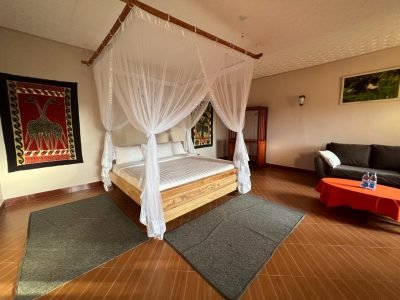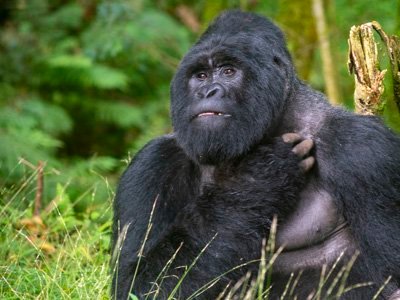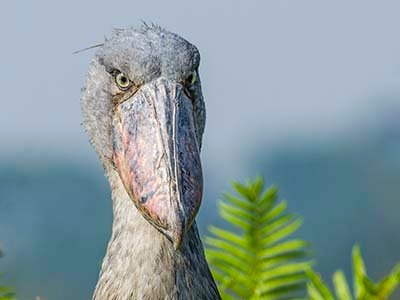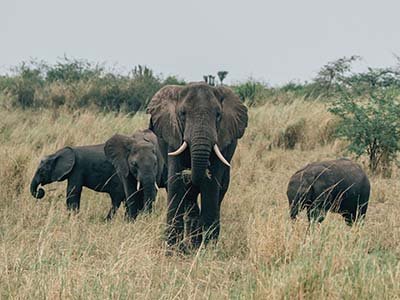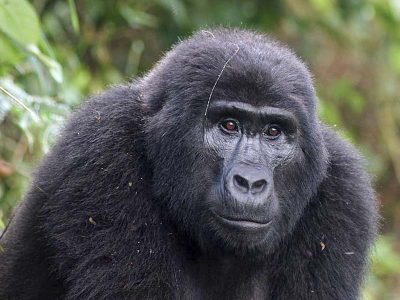Botanists and butterfly enthusiasts will find much to enjoy on a network of shaded forest trails, and birders will be in for a treat with 580 species reported.
Kibale National Park is Uganda’s grandest and most diverse expanses of tropical forest. On an elevated plateau, the northern and center portions of the park are mostly covered in forest, with a few spots of grassland and wetland intermingled Uganda Wildlife Authority
Wildlife in Kibale National Park
The park is home to a wide variety of animals, including 13 different kinds of primates. Sanctuary for these magnificent creatures, including habituated colonies of common chimpanzees that have been the subject of much research, is the park’s primary mission. Learn about the interesting behaviour of these clever animals by seeing them in their natural environment.
In addition, numerous species of Central African monkeys, including the Uganda mangabey, the Ugandan red colobus, and the L’Hoest’s monkey, call Kibale National Park home. When you go around the park’s forested areas, keep an eye out for the black and white colobus and the blue monkey.
Other than monkeys and chimpanzees, the red and blue duikers, bushbucks, sitatungas, bushpigs, giant forest hogs, common warthogs, and African buffalo may all be found in Kibale National Park. Furthermore, the magnificent elephants that frequent the park on their way between Kibale and Queen Elizabeth are a must-see.
Leopards, African golden cats, servals, many kinds of mongoose, and two types of otters are just some of the carnivores that call this park home. Predators like these are interesting to see, and they help keep the park’s environment healthy.
Kibale National Park is a great site to see primates because of the high concentration of these animals there. The park’s conservation efforts include safeguarding and preserving the natural habitats of several species of primates, which may be found in the park’s less damaged regions.
The avian life in Kibale National Park is equally as remarkable as the park’s outstanding terrestrial wildlife. Included among its 580 bird species are the Olive long-tailed cuckoo, western tinkerbird, African grey parrot, African pitta, and Green-breasted pitta. The park is already a natural symphony, but these birds’ songs make it much more so.
GETTING TO KIBALE NATIONAL PARK, UGANDA
The park located in western Uganda ( 00°30′N 30°24′E ) about 360km/224mi (approximately 6 hours) from Kampala the country’s capital. These are some suggested routes for getting to Kibale:
The first step is to fly into Uganda’s primary airport, Entebbe International Airport (code: EBB). It is roughly 29 miles (46 kilometres) from Uganda’s capital, Kampala. Flights to Entebbe are offered by a wide variety of international carriers, so you can choose the one that best fits your schedule and budget.
There are domestic flights available that connect Kibale National Park to other parks in Uganda. Booking domestic flights between parks is usually done by your tour operator and is generally included as part of your safari. Fly Uganda runs daily scheduled flights with ‘seat rates’ to Fort Portal, which is located 35km/20mi southeast of Fort Portal city.
Once you reach Fort Portal, the chimp trekking trailhead at Kanyanchu is just a 30- to 45-minute drive* away on a good surfaced road. The journey is comfortable and offers stunning views of the surrounding countryside.
Activities in Kibale National Park
- Chimpanzee trekking: The most popular attraction is chimpanzee trekking, which takes you through the lush forests in search of these amazing primates. For a more immersive experience, visitors can also participate in the chimpanzee habituation experience, which involves spending an entire day with a chimpanzee community as they go about their daily activities.
- Bird Watching: Birdwatching is another popular activity, with over 580 species of birds to spot in the park, including the rare olive long-tailed cuckoo and the western tinkerbird. Kibale is the only place in East Africa with the highest chances of spotting the Green breasted pitta.
- Primate Viewing: Primate viewing is also a must-do activity in Kibale National Park, with 13 different species of primates to observe during the day, including the black-and-white colobus and blue monkey. For those seeking a more unique experience, the park is renowned for its nocturnal bush babies and pottos, which can be seen during a night primate viewing experience.
- Cultural Encounter: In addition to wildlife activities, visitors can also engage in cultural encounters with local communities, where they can learn about traditional practices and customs.
- Swamp Walk: The Bigodi Swamp walk is another popular activity, offering visitors the chance to explore the wetlands and spot a variety of bird species and other wildlife, including primates and butterflies. Whether you’re a nature lover, adventure seeker, or culture enthusiast, Kibale National Park has something for everyone to enjoy.
The Bigodi Wetlands Sanctuary nature walk is organized by the Kibale Association for Rural and Environmental Development (KAFRED).
During your 3-hour, 4.5km walk through the sanctuary, you will have the chance to spot over 200 species of birds, including Turacos, Kingfishers, Parrots, Hornbills, Barbets, Tinkerbirds, Cranes, warblers and many other swamp endemics.
In addition to the rich birdlife, the sanctuary is also home to 8 species of primates, including the Red Tailed Monkey, Black and White Colobus monkey, Red Colobus moneky, L’hoest Monkey, Uganda Mangabey, Olive Baboon, Vervet Monkey, and Blue Monkey. Keep your eyes peeled for these playful creatures as they swing through the trees and go about their daily routines. Sitatunga an aquatic antelope is sometimes seen too.
| Guided Nature Walk | Cost in UG Shillings | Cost in US Dollars* |
| Visitor Category | Per Person | Per Person |
| Non-Residents of Uganda | UGS 50,000 | $23 |
| Residents who are not Ugandan | UGS 40,000 | $20 |
| Ugandans | UGS 10,000 | $5 |
Best time to Visit Kibale National Park
While the park is accessible year-round, the ideal time to go is in the dry season when the paths are clear and dry. December through February and then again from June through September are considered the dry seasons.
The dry season’s bright and mild weather is ideal for discovering the park’s natural beauties. Also, chimpanzees are more active and easier to locate during this time in their native environments. For chimpanzee trekking and other monkey-watching activities, this makes it a fantastic time.
During Kibale’s rainy season, which lasts from March to May and September to November, the park experiences heavy precipitation, especially in the northern parts. When trails are muddy and slippery, hiking and trekking may become more challenging. Yet, since migratory birds flock to the park around this time, the rainy season may also be a great time for birdwatchers to visit.
It is essential to remember that you should always check the forecast before to visiting the park, since the weather may be unpredictable. In addition, it is prudent to bring clothing suitable for both wet and dry weather to be prepared for any weather fluctuations.
Some Safari Packages offered by reputable tour operators
4 Day Wildlife and Chimpanzee Trekking Safari
This 4-day Wildlife and Chimpanzee Trekking Safari trip will take you on exhilarating wildlife and chimpanzee tracking excursions in Queen Elizabeth National Park and Kibale National Park, respectively.
12 Days Uganda Primate Safari Tour
13 Day Uganda Wildlife Photography Safari
The 13 Day Uganda Wildlife Photography Safari is a one-of-a-kind excursion across Uganda’s wildlife-rich countryside. This safari is intended to offer you an amazing experience as you tour two primate parks and a savannah park, with an emphasis on chimpanzees, gorillas, and Uganda’s gorgeous savannah landscapes.




